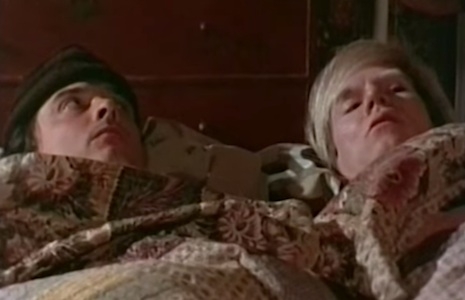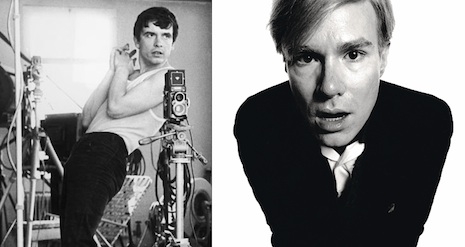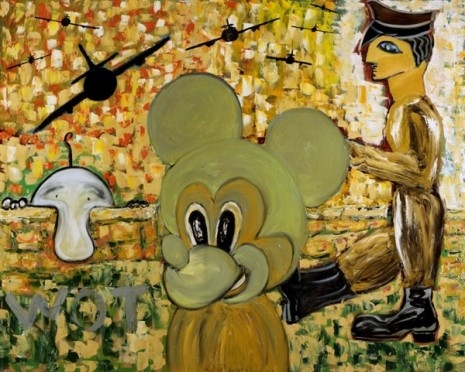
Among the reasons given for the banning of David Bailey’s documentary on Andy Warhol were: its possibly breach of the Vagrancy Act and a suggested sex act that was not “conducive to road safety.” These were the stated opinions of lawyer and judge Lord Justice Lawton and the sports journalist and broadcaster Ross McWhirter.
McWhirter was one-half of the famous twin brothers Ross and Norris McWhirter who compiled, wrote and edited the Guinness Book of Records. It was McWhirter who initiated the bizarre events that led to Bailey’s film being pulled from broadcast in January 1973, and temporarily banned until March of the same year. McWhirter was responding to the press previews for Bailey’s film that appeared in the Sunday papers on January 14th that described the film as “shocking,” “revolting,” and “offensive,” with the worst scene (erroneously) described by the Daily Mail as showing:
...a fat female artist [who] dyes her breasts and then rolls about on canvas ‘painting’...
This was Brigid Berlin making one of her famous “Tit Prints,” which was cited by Lord Lawton as a possible source of offense.

Director and subject.
David Bailey had spent about a year working on his documentary about Andy Warhol—it was the last of three films Bailey made for Lew Grade’s television company ATV, the other two were profiles of photographer Cecil Beaton and director Luchino Visconti—and he had spent considerable time with the often monosyllabic and elusive artist, and had interviewed many of Warhol’s Factory entourage including Candy Darling, Paul Morrissey, Fred Hughes, Jane Holzer and art dealer Leo Castelli. Bailey had given over directing duties to William Verity, while he spent his time asking questions and getting close to the film’s subject.
When ATV gave a press screening for Bailey’s Warhol, little did they consider that the negative response of the press would lead to the film being banned. When Ross McWhirter read the press previews, he was sufficiently disgusted that he saw an opportunity to strike a blow for the silent majority—for whom he believed himself to be the obvious spokesman. In fact, he was over-reacting to some hearsay about a film he had not seen.

On Monday 15th, McWhirter prepared to take out an injunction against the Independent Broadcasting Authority—the TV watchdog—for allowing Bailey’s film to be screened. On Tuesday January 16th, he issued a writ against the documentary to stop it being broadcast. However, McWhirter’s writ was dismissed during a one-minute High Court hearing. Like all zealots, McWhirter was not one to have the law stop him, and he appealed the High Court’s decision.
McWhirter’s actions gained support from an unlikely quarter: one of the ITV broadcast regions Anglia decided, after is chairman Lord Townshend and two members of the channel’s planning committee had watched the documentary, not to screen the documentary as Bailey’s film was:
...not of sufficient interest or quality.
McWhirter’s appeal was heard at 17:00hours on Tuesday January 16th, the day Warhol was set for broadcast. The Appeal Court consisted of Lord Justice Cairns, Lord Justice Lawton, and was presided over by Lord Denning. Although he had not seen the programme, McWhirter claimed in his writ that the press previews were sufficient to suggest the show would cause considerable offense. Any programme that was considered to be offensive to “good taste and decency” was to be banned under the guidelines of the Television Act of 1964.
Causing offense to the viewing public was not McWhirter’s only concern over Bailey’s film as his writ went on to describe some of its possible dangers:
At one point there is a conversation between a man dressed as a Hell’s Angel and a girl. In that piece, the girl discusses sex with the man and says she would like to have sex with him on the back of a motorcycle doing 60 miles an hour. Apart from anything else, that does not sound as though it is conducive to road safety.
Like McWhirter, none of the Lords had seen Bailey’s film, however this didn’t stop them pontificating about its possible criminal intent. According to the Guardian newspaper, Lord Justice Lawton was deeply concerned over Brigid Berlin’s breast painting:
...the viewers of Britain were to be shown pictures of a fat lady doing something that sounded to him very much like a breach of the Vagrancy act, apart from anything else…

The offending “tit printing” scene.
However, it was the IBA who received the greatest criticism from Lord Denning for their perceived failure to view the documentary before transmission. This, as it later turned out, was a major oversight by Denning and co. as they had failed to ascertain whether anyone from the IBA had actually watched the film—which in fact they had. IBA General Director Brian Young, Head of Programmes Joe Wellman, together with their deputies, had all watched Bailey’s film and suggested cuts and had even insisted on the addition of an introductory voice-over.
Still this did not stop the appeal judges voting 2-1 in favor of an interim injunction that temporarily banned the film from being screened on television—a documentary on craftwork was broadcast instead.
Watch David Bailey’s ‘Warhol’ after the jump…










